When we think ofPre-Raphaelite art, our mind flies to the sensual women of Dante Gabriel Rossetti (London, 1828 - Birchington-on-Sea, 1882) and the myths and legends imprinted on canvas by Edward Burne-Jones (Birmingham, 1833 - London, 1898), but in reality it is a movement strongly linked to the historical and cultural events of the time. In mid-nineteenth-century Britain, when the country was dominated by the strong personality of Queen Victoria, a sovereign considered for her long reign and her attitudes to morality and economic prosperity to be the proponent of the most stable and prosperous period in England’s history, had seen the birth of Pre-Raphaelism, a cultural movement that intended to revolutionize the thinking and the way art was made at the time. The queen who so incited morality reigned over a society characterized by great differences between the upper and lower classes, even more reinforced by the industrial revolution. Children and the very young were employed in factories and mines under exploitative conditions (think of the protagonists in Charles Dickens’ novels), and the quality and hours of work of workers in industries were nothing short of inhumane: it was believed that all of this was necessary to lead England to a strong economic expansion. Artistically, painting was confined to theacademicism perpetuated by London’s Royal Academy of Arts and the desire to express morality.
It was within this institution that three young students had studied who decided to change the art scene by founding the Pre-Raphaelite Brotherhood in 1848. The three protagonists of the “revolution” were William Holman Hunt (London, 1827 - 1910), John Everett Millais (Southampton, 1829 - London, 1896) and Dante Gabriel Rossetti. The very name of the movement referred to the principles of their art: in fact, Pre-Raphaelism indicates the desire to return to the “primitives,” that is, the artists who precededRaphael’s art. For them, Raphael (or rather: the Roman Raphael) symbolized academic art, the greatest exponent of the Renaissance, a period to which the Pre-Raphaelites traced the first mercantilist contaminations, since the phenomenon of patronage had been widely developed at that time. Raphael’s art had given rise to modern painting because it had influenced the taste of subsequent centuries. In particular, William Hunt had criticized the Transfiguration created by the Urbino artist as a model not to be followed because of the haughty posture of the apostles and the unspiritual attitude of the Savior and especially because of the failure to depict the simple character of truth. Condemning Raphaelite art, the Pre-Raphaelites intended to takemedieval and early Renaissance art as a model, free and pure, and return to the simplicity of nature. The exponents of the new movement dreamed of a Middle Ages that harked back to remote pre-industrial eras and a craftsmanship that was once again free and not falsified by “molds”; they dreamed of a painting that would exclude the great moving masses immortalized on canvases in the late 18th and early 19th centuries.
The most recurrent Pre-Raphaelite themes were therefore literary quotations or from myths: subjects from Dante, the Bible, and medieval legends were frequent, reproduced on canvas with an atmosphere between the mystical and the sensual. A fervent supporter of Pre-Raphaelism was John Ruskin (London, 1819 - Brantwood, 1900), a writer and critic who was heavily opposed to the materialism andutilitarianism of industrial civilization. His essay titled The Pre-Raphaelitism through which he becomes the proponent of the English movement and explicitly criticizes the contemporary socio-economic reality, industrial society guilty of the degradation of man to machine, work in inhumane conditions, and the change in a negative sense of England’s landscape, dates from 1851. For him, the critique against factory machines was a critique on behalf of humanity and morality. Ruskin proposed a moral conception of art, to which he conferred a social role, advocated the need for a valorization of craftsmanship as opposed to the brutalization of industrialization, and advocated a poetic and mystical vision of nature that should be represented in a real and truthful way.
From a technical point of view, Pre-Raphaelite paintings were characterized by bright colors and, as mentioned above, religious and literary references, simplicity of nature, and a certain freedom in the depiction of characters. Precisely because of the literary tradition, the movement had gained public and critical acclaim, despite the innovations made artistically. Among the various exponents, who had been joined at the beginning by the sculptor and poet Thomas Woolner (Hadleigh, 1825 - London, 1892), James Collinson (Mansfield, 1825 - Camberwell, 1881), Dante Gabriel Rossetti’s brother William Michael Rossetti (London, 1829 - 1919), and Frederick George Stephens (London, 1828 - 1907) , the one who is still to be regarded as the most famous is undoubtedly Dante Gabriel Rossetti, author of sensual and symbol-bearing women. And it is from the latter that another artist, who became representative of the second generation of the movement, had learned the lines of Pre-Raphaelite art: Edward Burne-Jones.
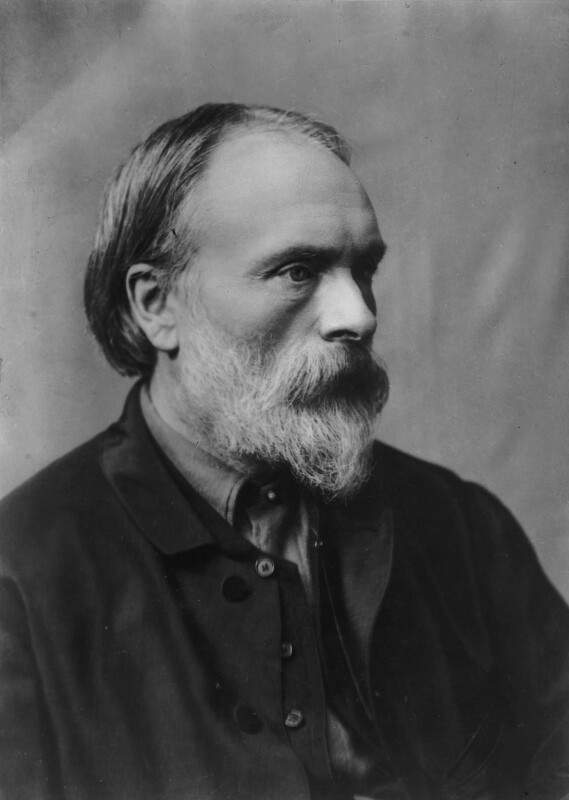 |
| Elliott & Fry, from Alfred James Philpott (Phillpot), Portrait of Edward Burne-Jones (1885; photographic negative; London, National Portait Gallery) |
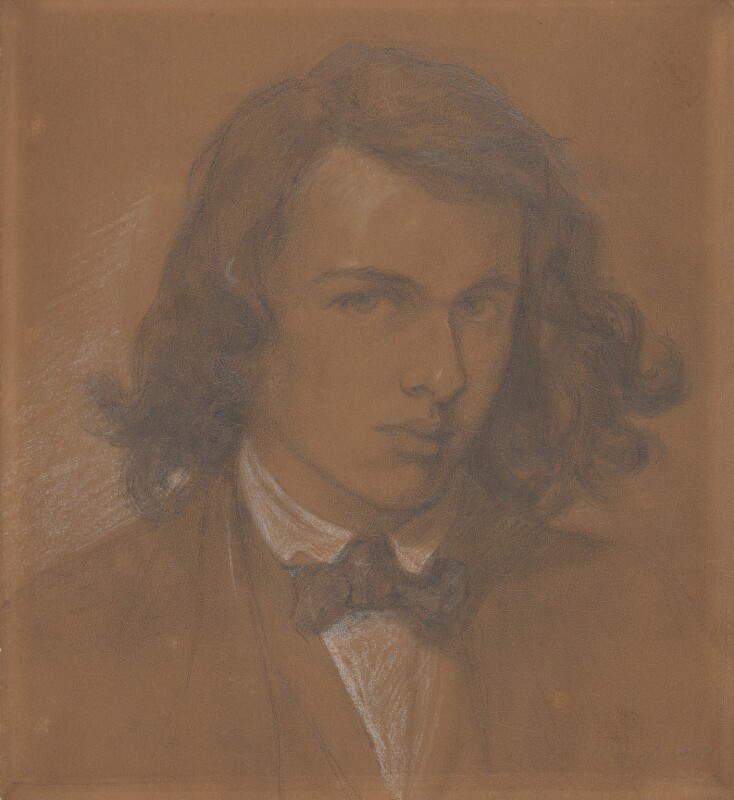 |
| Dante Gabriel Rossetti, Self-Portrait (1847; pencil and white chalk on paper, 207 x 168 mm; London, National Portait Gallery) |
Like Rossetti, Burne-Jones was attracted to literature, poetry, and the Middle Ages, and therefore learned from him what had been the innovations of his era. In addition, the two had in common a love ofItalian art, made explicit by Dante Gabriel Rossetti beginning in 1850 in his Sonnets for Pictures, a series of sonnets composed by the artist himself and dedicated to works of art by important artists such as Mantegna (Isola di Carturo, 1431 - Mantua, 1506) or Giorgione (Castelfranco Veneto, c. 1478 - Venice, 1510): the sonnets were placed as definitions, commentaries or translations of the images themselves, highlighting Rossetti’s multidisciplinary character and the strong link that can be established between painting and poetry. Despite the relationship of friendship and esteem between the two artists, Rossetti’s direct influence had soon waned, and John Ruskin, who had been involved in Burne-Jones’s education since 1856, had taken his place: the critic had gradually abandoned his interest in the Middle Ages, as he believed that it detracted from his contact with nature and reality, and had prompted him to discover Italian art directly. Testimony to his subsequent trip to Italy are the artist’s notebooks: in the peninsula he had been able to admire masterpieces by Giotto (Vespignano, 1267 - Florence, 1337), Filippo Lippi (Florence, 1406 - Spoleto, 1469), Masaccio (San Giovanni Valdarno, 1401 - Rome, 1428), Botticelli (Florence, 1445 - 1510), Titian (Pieve di Cadore, 1488/1490 - Venice, 1576), Giorgione and many others. Ruskin had also induced him to delve into Italian works preserved in England: one among many examples to be mentioned is that of the Portrait of Margherita Paleologa by Giulio Romano (Rome, c. 1499 - Mantua, 1546) and housed in the Royal Collection Trust in London from which Burne-Jones was inspired for the dress of Sidonia von Bork. However, English collecting was also already a participant in this interest in Italian art: part of John Eastlake ’s collection was the Satyr bent over a nymph by Piero di Cosimo (Florence, c. 1461 - 1522), which the collector had purchased in Florence in 1857 from the Lombardi Baldi collection; from Piero di Cosimo’s masterpiece the English artist had been inspired for his Pan and Psyche.
And still in Italy, Burne-Jones had become acquainted with the Michelangelo (Caprese, 1475 - Rome, 1564) of the Sistine Chapel, grasping in the Florentine artist the perennial torment and energy that flows from his sign; in particular, the English painter would have been influenced by Michelangelo’s nude. The figure of Botticelli had also been significant to him: attracted by the painter’s apparent paganity that evokes a distant and extinct mythology, Burne-Jones was also fascinated by the Florentine painter’s soft lines and the grace that invaded the characters he depicted. He had nevertheless felt close to his pictorial language the art of Giorgione, characterized by a symbolism that still remains in many cases mysterious, not entirely deciphered; a painting that expressed harmony but was rich in symbolism and quotation.
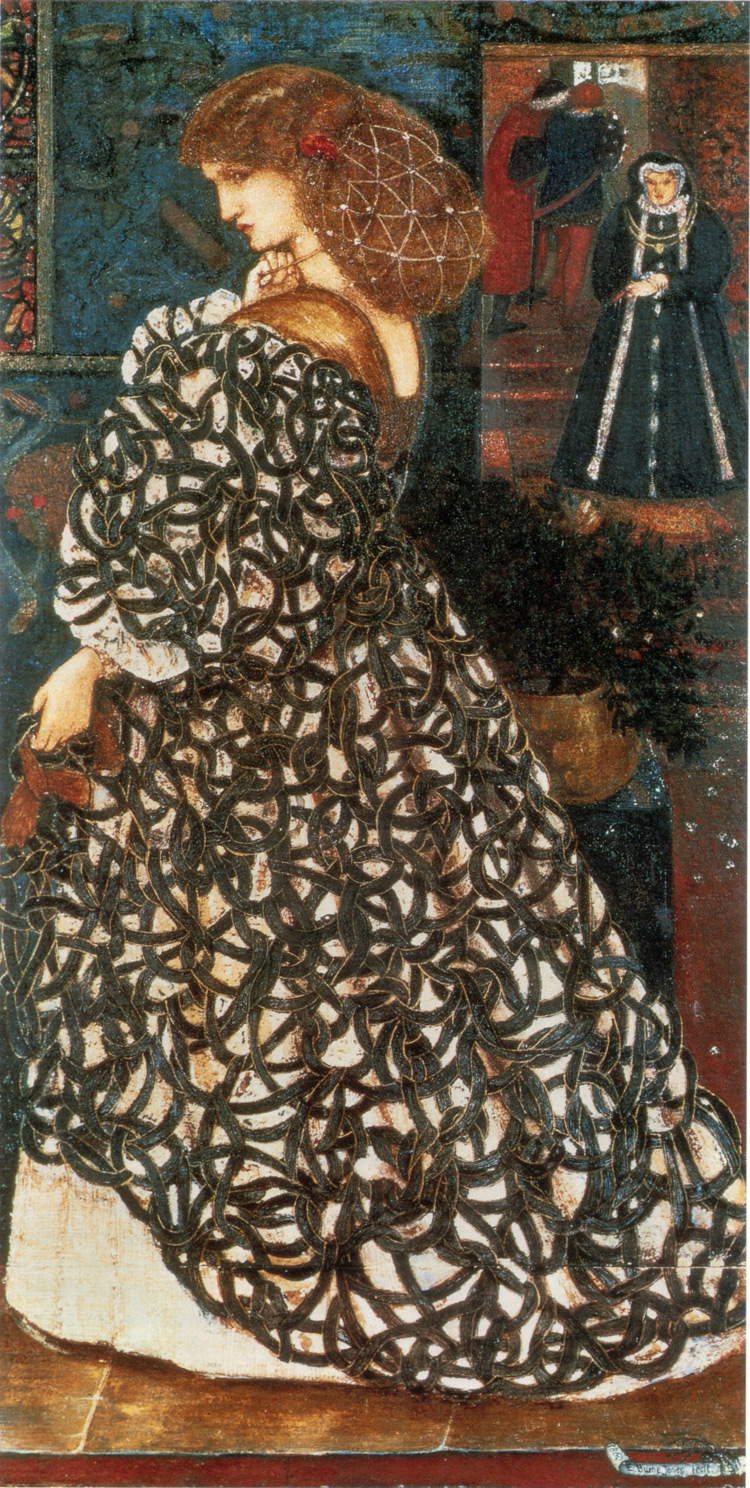 |
| Edward Burne-Jones, Sidonia von Bork (1860; watercolor and gouache on paper, 333 x 171 mm; London, Tate Britain) |
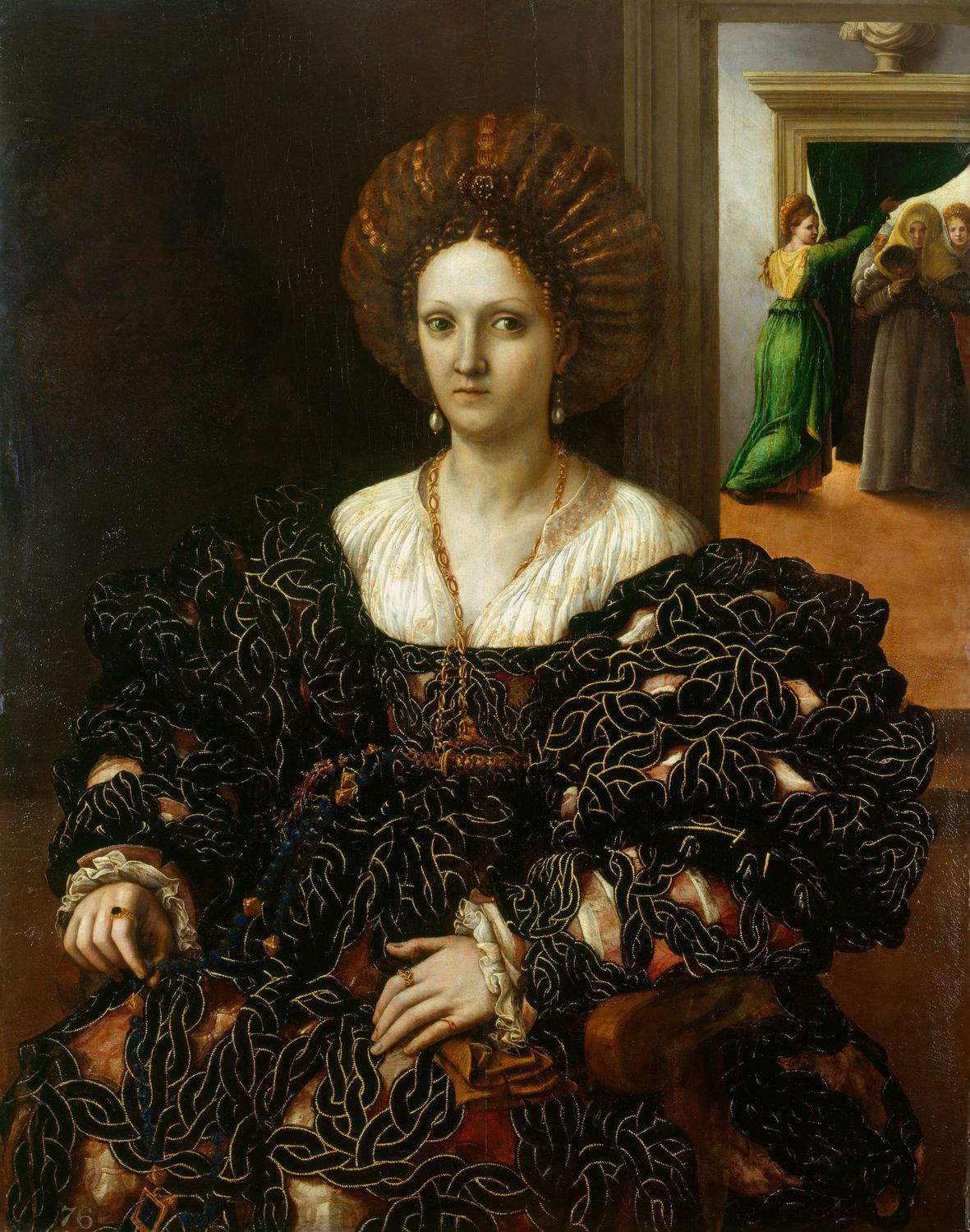 |
| Giulio Romano, Margherita Paleologa (1531; oil on panel, 115 x 90 cm; London, Hampton Court) |
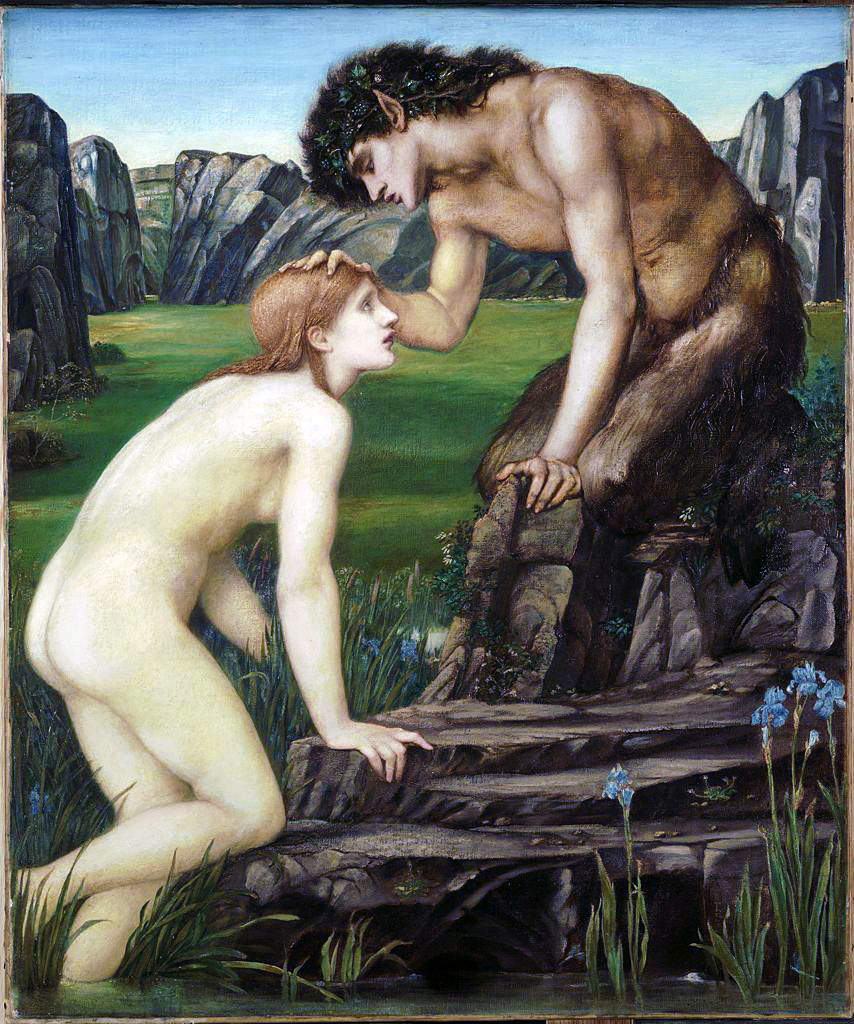 |
| Edward Burne-Jones, Pan and Psyche (1872-1874; oil on canvas, 65.1 x 53.3 cm; Cambridge, Massachusetts, Fogg Art Museum) |
 |
| Piero di Cosimo, Satyr Mourning the Death of a Nymph (c. 1495-1500; oil on panel, 65.4 x 184.2 cm; London, National Gallery) |
In addition to artistic influences, it is necessary to mention the literary influences that played an important role in his painting. Thanks to his friendship with William Morris (Walthamstow, 1834 - Hammersmith, 1896), he had deepened his knowledge of English popular culture, including the legends of the Arthurian cycle and the Border Ballads, the so-called frontier ballads typical of the Anglo-Scottish area; he had also planned together with Morris to illustrate The Earthly Paradise, the epic poem written by the latter between 1868 and 1870 in which classical myths, Scandinavian and medieval legends were brought together. The drawings he had begun to make for this project had subsequently been the inspiration for the composition of his great cycles, from Cupid and Psyche to Perseus, from Pygmalion to the Wild Rose.
Here we have chosen to analyze the latter cycle, since it is an unusual theme that has been little addressed in art history, despite the fact that the story is well known in the literary field. In fact, the other cycles are devoted to much more frequent stories in paintings and sculptures. Burne-Jones had begun making the first series of the Wild Rose in 1870, thus, as already stated, in conjunction with the unfinished project of illustrating Morris’s epic poem. Fruit of this first version had been the so-called Small Briar Rose series, which includes three paintings, The Briar Wood, The Council Chamber and The Rose Bower; the series is exhibited in Puerto Rico, at the Museo de Arte de Ponce. Instead, the later series of The Legend of the Wild Rose, inspired by the same subject but consisting of four paintings, has been attested between 1885 and 1890: The Garden Court had been added to the three in the previous series. These still decorate an entire hall of Lord Faringdon’s residence, Buscot Park,Oxfordshire, now part of the National Trust. An 18th-century mansion that had been influenced by Italian architecture, as it was inspired by the art of Andrea Palladio (Padua, 1508 - Maser, 1580). When the English painter had visited the villa and admired its paintings placed in the beautiful salon, he had decided to extend the frames of each painting and add ten panels to continue the floral motif.
 |
| Burne-Jones’ works in the drawing room of Lord Faringdon’s residence, Buscot Park |
Inspiration for depicting the subject of the legend of the Wild Rose had come to him from the story of Sleeping Beauty, a tale introduced in Charles Perrault’s famous Contes du Temps Passé, published in 1697, and rediscovered in the nineteenth century thanks to the Grimm brothers’ version, Rosaspina, and Alfred Tennyson ’s poem entitled The Day-Dream, published in 1842. The events of Sleeping Beauty are known to all, but Burne-Jones had chosen to depict in his cycle only one moment in the story, namely when the brave prince, after fighting with the forest of brambles, first arrives before the court victim of the spell, and later by the princess whom he must awaken with a kiss. He had decided not to depict the continuation of the story, but to stop at the princess still asleep, who has therefore not yet received true love’s kiss. There is no progressive narrative, but rather a world that remains slumbering and impenetrable.
The series begins with The Briar Wood: among the tangled brambles of the wild rose that occupy the entire painting, five soldiers are depicted asleep in a deep slumber; even parts of their armor, shields, and swords have been trapped in the brambles. Arriving on the enchanted scene is the prince, placed on the left side of the canvas, wearing shining armor and holding the sword with which he made his way through the tangled thicket. The painting is accompanied by an inscription bearing a poem by William Morris composed for this very work: “The fateful slumber floats and flows / About the tangle of the rose. / But Io the fated hand and heart / To rend the slumberous curse apart.” Sleep indeed reigns in the tangle of the rose, but the prince’s hand and heart will break this curse.
In the next scene entitled The Council Chamber deep sleep still reigns: here to be asleep are the king, seated on the throne, and the members of the council, lying on each other or resting on their elbows or even standing. Behind the curtains other soldiers can be glimpsed sleeping. Morris’ poem related to the painting reads, “The threat of war the hope of peace / The kingdoms peril and increase / Sleep on and bide the latter day / When fate shall take his chain away.” The kingdoms will peril and increase, sleep on and bide the latter day when Fate shall take its chain away.
The third canvas, The Garden Court, depicts the outside of the castle where young maidens are abandoned to sleep, weavers asleep on their looms. Around them are tangled arches of roses. The young women of the kingdom do not speak or weave. As Morris writes: “The Maiden plaisance of the land / Knoweth no stir of voice or hand / No cup the spleeping waters fill / The restless shuttle lieth still.”
The cycle ends with The Rose Bower, the sleeping beauty lying on her bed with three other maidens, her servants, also abandoned in deep sleep. The curtain in the background is now lifted by the rose bushes, which are about to invade the bed. Morris’s inscription reads, “Here lies the hoarded love the key / To all the treasure that shall be / Come fated heart the gift to take / And smite the sleeping world awake.” Here lies the hoarded love, the key to all the treasure that shall ever be, and the sleeping world shall be awakened. But Burne-Jones’ Wild Rose series does not include the awakening of the princess. Every living form is reduced to silence andstillness except the prince on the outer edge of the first painting in the series.
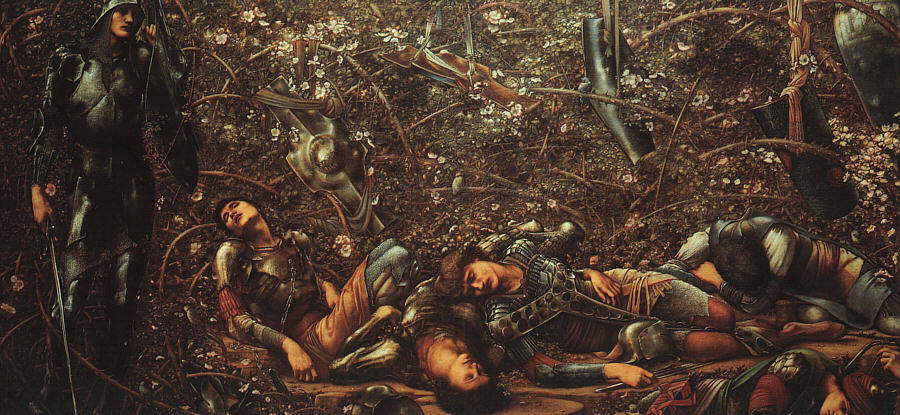 |
| Edward Burne Jones, The Briar Wood, from The Briar Rose series (1885-1890; oil on canvas, 124.5 x 249.3 cm; Buscot, Buscot Park) |
 |
| Edward Burne Jones, The Council Chamber, from The Briar Rose series (1885-1890; oil on canvas, 124.5 x 249.3 cm; Buscot, Buscot Park) |
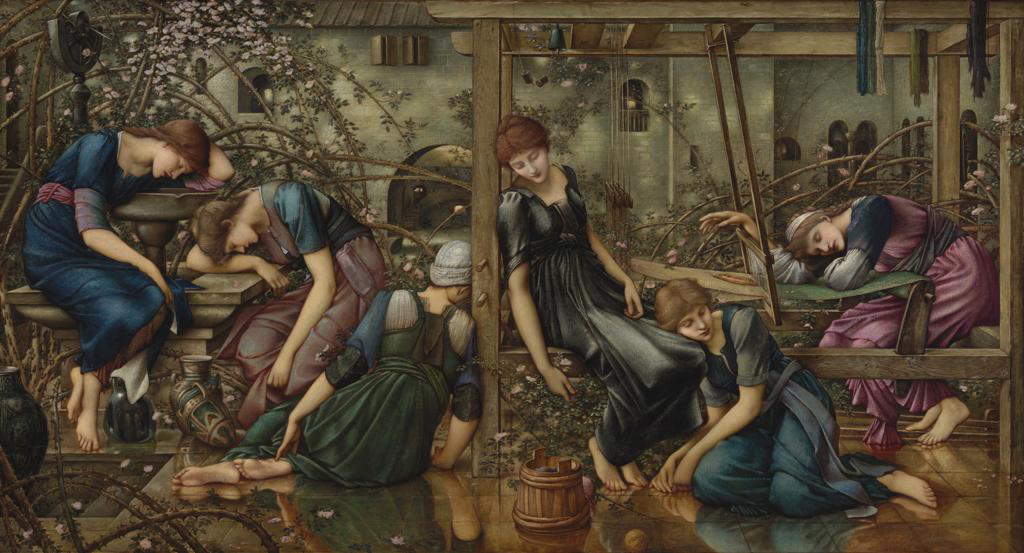 |
| Edward Burne Jones, The Garden Court, from The Briar Rose series (1885-1890; oil on canvas, 124.5 x 249.3 cm; Buscot, Buscot Park) |
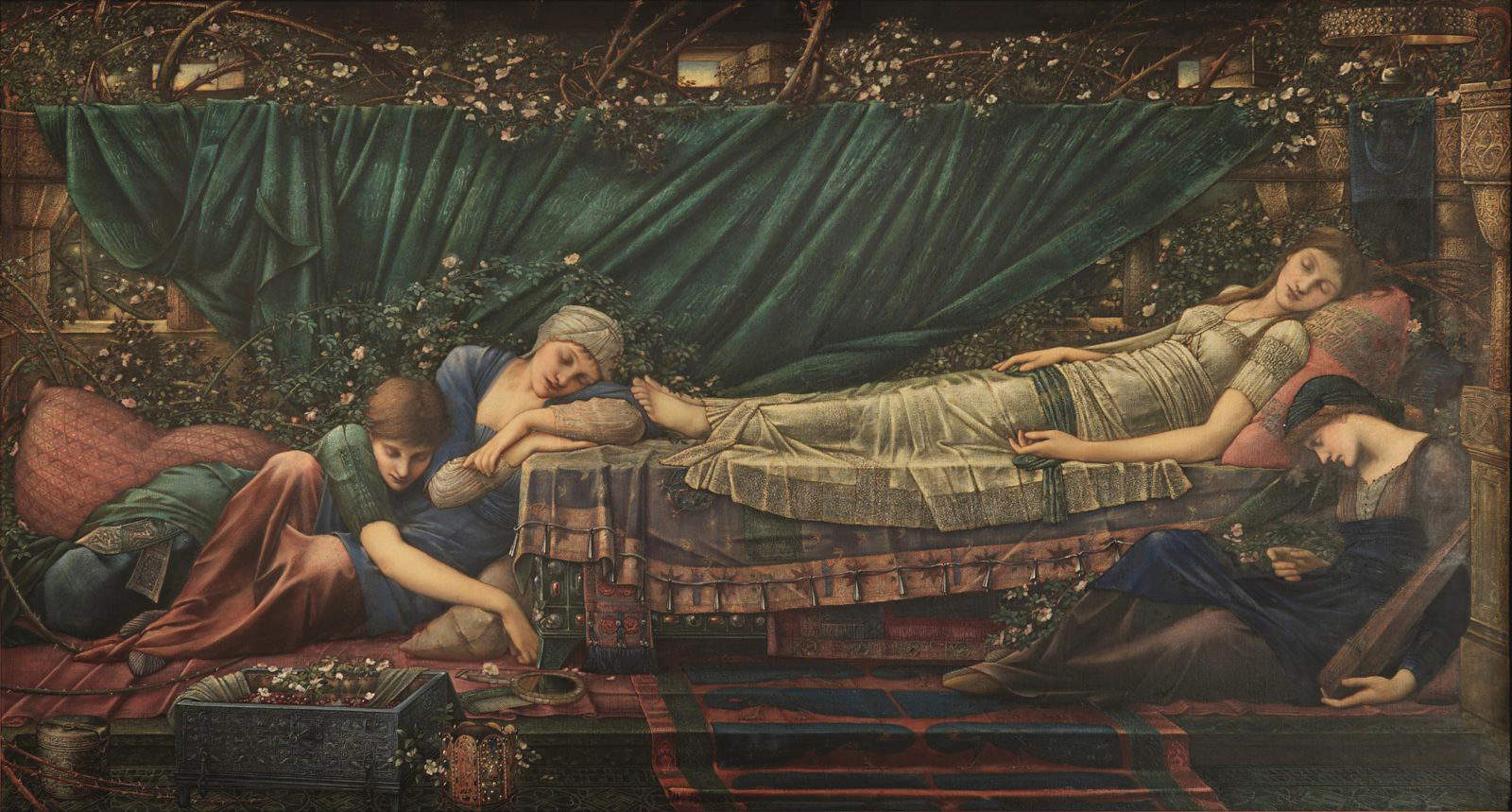 |
| Edward Burne Jones, The Bower Rose, from The Briar Rose series (1885-1890; oil on canvas, 124.5 x 249.3 cm; Buscot, Buscot Park) |
All the canvases that make up the cycle of the legend are characterized by strong chromaticism and attention to brightness and reflections: this can be seen in the armor of the knights, the robes of the council members and their hands reflecting on the floor, the maidens in the castle garden and their hands and feet on the surface. One also notices care in the draperies and softness in the lines. However, one can also perceive theGiorgionesque influence (think, for example, of his Venus), as painting often hermetic, intimate. The deep sleep of the characters depicted in the cycle could signify the existence of a reality without positive changes or as a kind of barrier in the face of the profound changes caused by industrialization that occurred in the artist’s time.
After the series preserved at Buscot Park, Burne-Jones had made another series with the same subject: composed of three paintings, these are located in different collections from each other; The Garden Court can be seen at the Bristol City Museum & Art Gallery, The Council Chamber at the Delaware Art Museum, and finally The Rose Bower in Dublin, at the Hugh Lane Gallery of Modern Art. The story of Sleeping Beauty has now become one of the most famous of Disney’s animated films, released in the United States in 1959, but Edward Burne-Jones’ canvases of it represent one of the masterpieces of nineteenth-century English art history. Paintings that exude amagical atmosphere , in front of which for a kind of identification it is natural to remain silent, perhaps to leave the action fully to the prince. However, to witness the awakening of the beautiful princess one will necessarily have to resort to the successful Disney cartoon.
Reference bibliography
 |
| Giorgione and Titian, Sleeping Venus (c. 1507-1510; oil on canvas, 108.5 x 175 cm; Dresden, Gemäldegalerie) |
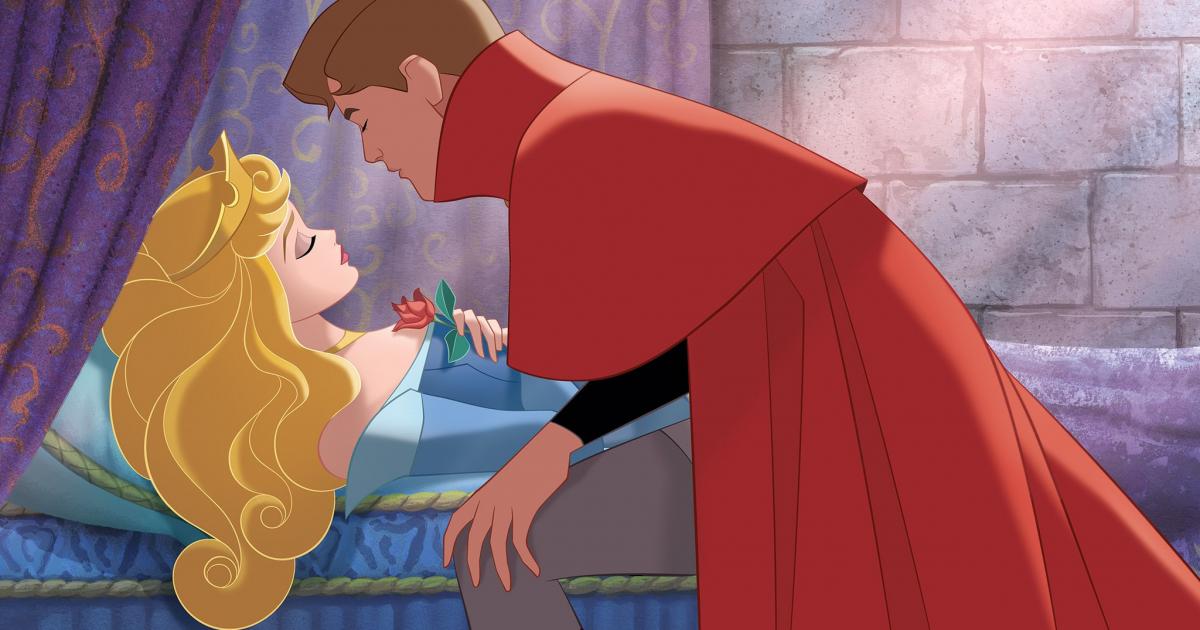 |
| A still from Disney’s Sleeping Beauty in the Woods. |
Warning: the translation into English of the original Italian article was created using automatic tools. We undertake to review all articles, but we do not guarantee the total absence of inaccuracies in the translation due to the program. You can find the original by clicking on the ITA button. If you find any mistake,please contact us.